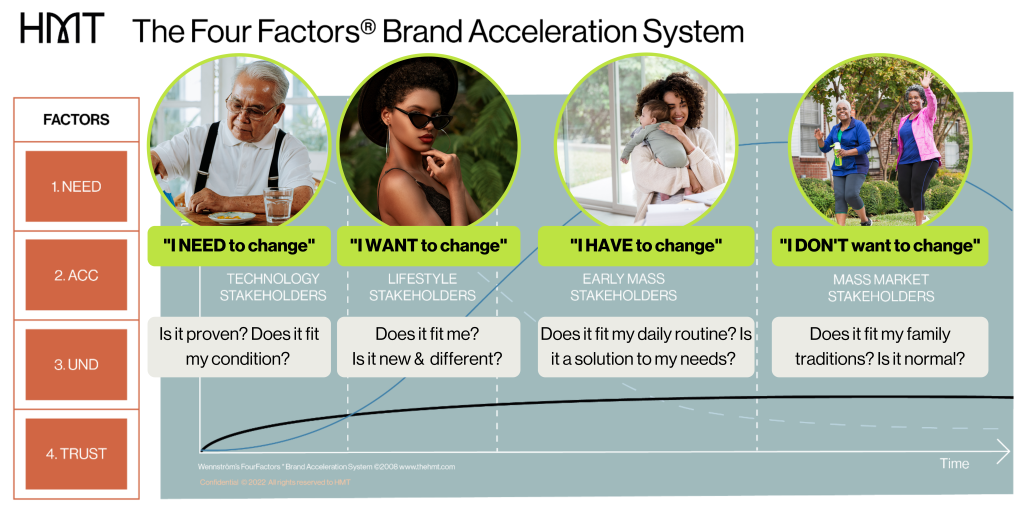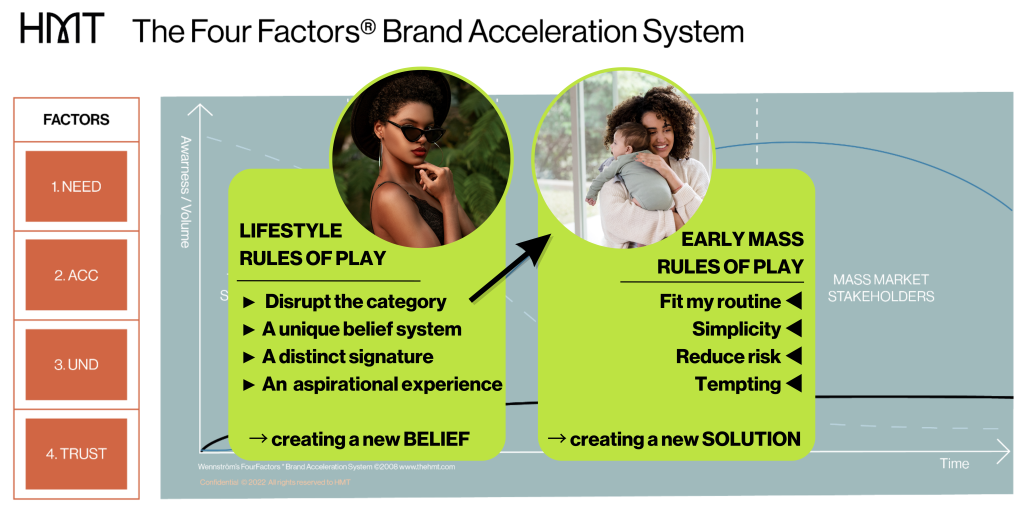Four critical success factors for a plant-based brand:
Learning from the best: Oatly and WhatIF Foods
The key success factors of 10 years ago are still applicable today.
When we worked with the repositioning of Oatly in 2012, the plant-based market was emerging, and Oatly, being one of the very few players out there, could take the lead in the whole plant-based dairy category with “Wow no cow!”. Today, new plant-based brands face a market that is becoming extremely crowded. So, the challenges for today’s startups are: How do you break through the noise? How do you stand out in a crowded market? And for scale-ups: How do you successfully enter new markets?
We have summarised the critical success factors that can help you succeed in the plant-based market, with key learnings from HMT’s own plant-based projects from today’s leading global brand Oatly and tomorrow’s runner-up brand WhatIF Foods.

How to move from a me-too product to a differentiated brand?
Although separated by a decade, WhatIF Foods and Oatly were facing similar challenges at the beginning of their journey. Both started by entering a niche market with a niche product, focusing on the science and technology of the ingredient, without a clear consumer target and without building an emotional differentiation i.e. a brand. This resulted in many different product messages, creating confusion for who this product actually is meant for. So the first challenging question must be answered: who is the right target consumer that can be the basis for your future?

Emotional differentiator vs product features
WhatIF Foods, a plant-based food company founded in Singapore with the mission to change the way everyday foods are made, started its business in the Asia Pacific with plant-based milk and noodles products based on the forgotten crop Bambara Groundnut (BamNut), grown by local communities in West Africa. Their purpose is grounded on regenerative principles to replenish today’s food with nutrients, restore the fertility of the soils and reconnect with local farming communities. The products are aimed at future generations, Gen Z, who are invited to the brand movement “Join the Regeneration!” to make regeneration a part of their lifestyle. However, the challenge remains as most Asian consumers still prioritise health and taste over sustainability, so an important decision was to launch in the USA where the consumer mindset is totally different. Our insight team identified climate anxiety as a reality for a majority of Gen Z.
Chris Langwallner, CEO and founder of WhatIF Foods: “Once you embrace the emotional side of what you can become as a brand, you unleash a new dimension. That’s how you connect with consumers.”

Critical success factors for WhatIF Foods
WhatIF Foods is now growing successfully in both Asia and in the US market. The following critical success factors have contributed to the brand’s success.
- Clear target group: together with WhatIF Foods, we identified the target group of Gen Z, the future generations, who lost hope and fear for their future and the future of the planet. This generation doesn’t trust the government to take action but instead feels that brands are in the right place to make real change with lasting impact, and they want to be a part of this. WhatIF Foods was able to connect to a movement for those who are not settling with good but always strive for a “better better”. WhatIF Foods is now able to connect and engage with a new movement that wants to “Be the Regeneration” with a brand communication platform based on creating “lust for life”.
- Strong Roots: WhatIF Foods has a strong heritage and technology rooted in the science and regenerative farming practices for the Bamnut ingredient, which helps in establishing its credibility as a plant-based brand. In addition, WhatIF Foods shows the impact they are making throughout the whole value chain, from supporting the life of local farming communities in Africa to the health and wellness of its consumers in both eastern and western markets.
- Strong Purpose: The brand has a strong purpose that is translated into everything they do: product development, communication and brand activities, and company culture. HMT’s FourFactors® Brand Torch process supported in articulating the purpose of WhatIF Foods “to create lust for life through regenerative principles and always strive for a better tomorrow.” This purpose-driven approach of “carrying the brand torch” must be translated through all Marketing P’s and only then can help the brand to stand out and connect with its target audience.
- Strong Missionary Leadership: a disruptive brand needs a disruptive leader who can activate the brand’s purpose from the inside out and carry the “brand torch”. WhatIF Foods has this strong missionary leadership which helps create a culture and community that is true to the brand’s values and purpose.

How to stay competitive and grow the brand?
To remain competitive and grow the brand, you have two options:
- Option 1: Stay in the lifestyle segment and focus on building a strong premium niche brand based on purpose. This approach would require the brand to stay true to its purpose and values, grow its product portfolio within the premium niche, expand its geography within the same premium niche, work with influencers, and invest heavily in marketing and communication.
- Option 2: Grow volumes by entering the mass market and becoming available to a wider audience. This means that the rules of the game are changing: you must understand the mass market consumer! (download here for free the Triggers & Barriers for Mass Market Entry Report). To enter the mass market will mean a shift from value to volume, and it will require the brand to develop new products that cater to mass market consumers (convenient solutions), focus more on health and taste benefits rather than ethical benefits, and work on reducing the price point to make the products more accessible.

Conclusion: check your brand against the success factors as a start
In conclusion, plant-based brands face several challenges in today’s crowded markets, but learning from the four success factors that are shared by WhatIF Foods and Oatly is a good start.
- Clear consumer target,
- Strong and transparent roots,
- Strong purpose,
- Strong missionary leadership
With both WhatIF Foods and Oatly, we helped a technology/science-focused founder grow the business by finding the emotional differentiation i.e. to create a strong brand. The Brand Torch process takes the management team and its stakeholders through a process where you define the source of the brand, it’s competitive positioning and the “flame” that will attract its target consumers.
If you are curious to understand more about the critical success factors of Oatly? Read more here.